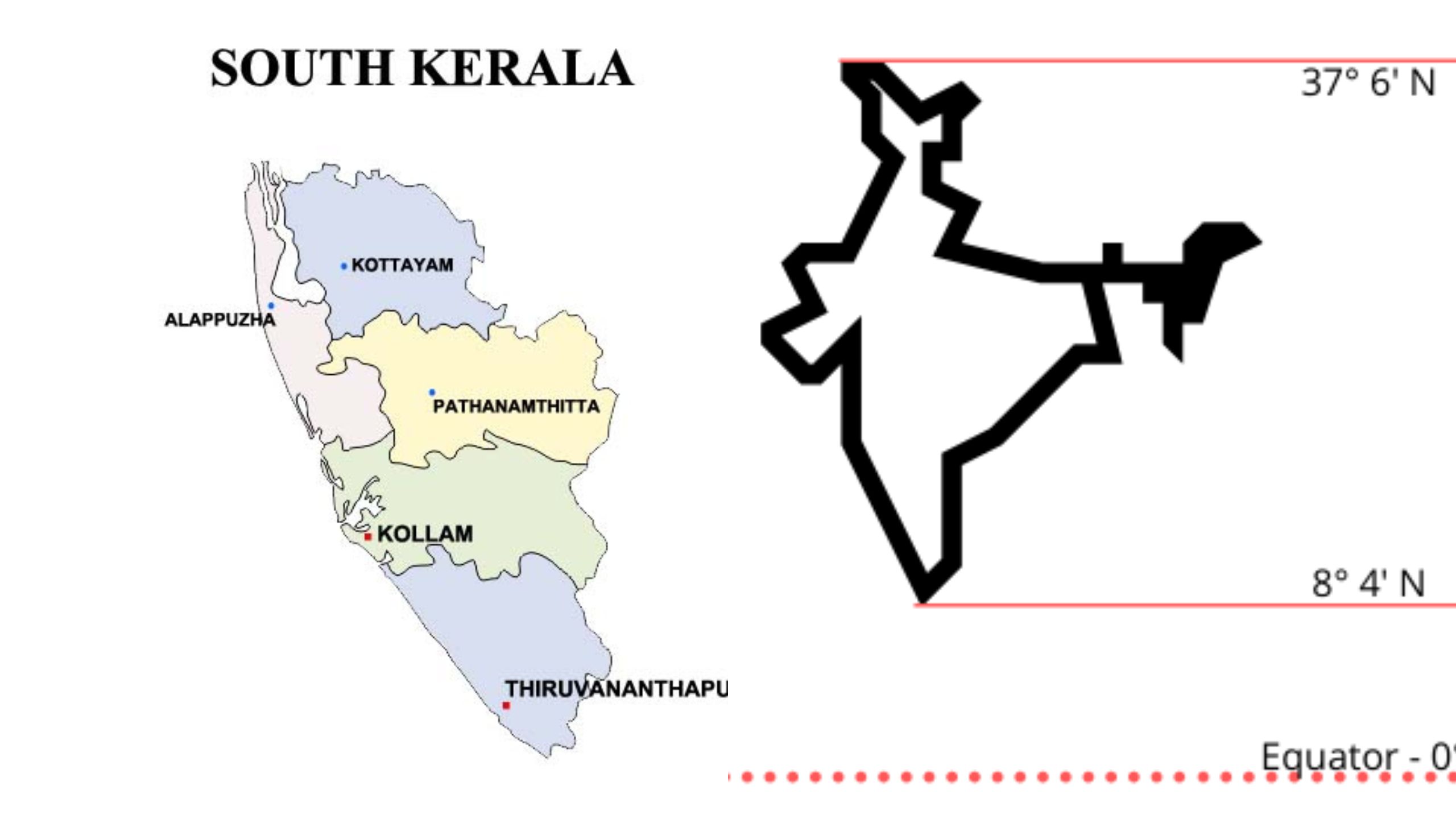Class 11 Geography NCERT Solutions Chapter 9
1. Multiple choice questions.
(i) The sun is directly overhead at noon on 21st June at:
(a) The equator
(b) 23.5° S
(c) 23.5° N
(d) 66.5° N
Answer: (a) The equator
Explanation: On June 21st, the summer solstice occurs in the Northern Hemisphere, the Sun is directly overhead at noon at the Tropic of Cancer (23.5° N), which is close to the equator. This phenomenon occurs due to the tilt of the Earth’s axis and results in the longest day of the year in the Northern Hemisphere.

(ii) In which one of the following cities, are the days the longest?
(a) Tiruvanantpuram
(b) Chandigarh
(c) Hyderabad
(d) Nagpur
Answer: (a) Tiruvanantpuram
Explanation: The length of daylight varies throughout the year depending on the location’s latitude. Generally, cities closer to the equator experience less variation in daylight hours compared to those farther away.

Tiruvanantpuram is located closer to the equator in southern India. Hence, it will have a longer day.

(iii) The atmosphere is mainly heated by the:
(a) Short wave solar radiation
(b) Reflected solar radiation
(c) Long wave terrestrial radiation
(d) Scattered solar radiation
Ans: (c) Long wave terrestrial radiation
Explanation: The Earth’s surface is heated by incoming short wave solar radiation, and it then emits long wave terrestrial radiation (heat). This terrestrial radiation is absorbed by gases in the atmosphere, which contributes to the warming of the atmosphere.

(iv) Make correct pairs from the following two columns.
| Term | Definition |
| (i) Insolation | (c) The incoming solar radiation |
| (ii) Albedo | (d) The percentage of visible light reflected by an object |
| (iii) Isotherm | (b) The lines joining the places of equal temperature |
| (iv) Annual range | (a) The difference between the mean temperature of the warmest and the coldest months |
Ans: 
(v) The main reason that the earth experiences highest temperatures in the subtropics in the northern hemisphere rather than at the equator is :
(a) Subtropical areas tend to have less cloud cover than equatorial areas.
(b) Subtropical areas have longer day hours in the summer than the equatorial.
(c) Subtropical areas have an enhanced “green house effect” compared to equatorial areas.
(d) Subtropical areas are nearer to the oceanic areas than the equatorial locations.
Ans: (a) Subtropical areas tend to have less cloud cover than equatorial areas.
Explanation: The higher temperatures in the subtropics (around 30° latitude) compared to the equator can be attributed to the fact that subtropical areas tend to have less cloud cover. This allows more direct solar radiation to reach the surface, leading to greater heating.
The equator, while receiving more intense solar radiation, experiences more cloud cover and frequent convection, which somewhat moderates its temperatures. The distribution of temperature is influenced by a combination of factors including solar angle, cloud cover, and atmospheric circulation patterns.
2. Answer the following questions in about 30 words.
(i) How does the unequal distribution of heat over the planet earth in space and time cause variations in weather and climate?
Ans: Unequal solar radiation creates temperature gradients, driving atmospheric circulation and wind patterns. Earth’s axial tilt and revolution cause seasonal changes, influencing climate zones, temperature, and precipitation patterns, resulting in diverse weather phenomena and long-term climate variations.
(ii) What are the factors that control temperature distribution on the surface of the earth?
Ans: Latitude, altitude, ocean currents, atmospheric circulation, land-water contrasts, cloud cover, albedo, greenhouse gases, and human activities influence temperature patterns.
(iii) In India, why is the day temperature maximum in May and not after the summer solstice?
Ans: Day temperatures peak in May due to the lag of insolation; land takes time to heat, causing a delay after the solstice.
(iv) Why is the annual range of temperature high in the Siberian plains?
Ans: Siberian plains experience wide annual temperature fluctuations due to their continental location, absence of nearby water bodies, and low moisture content.
3. Answer the following questions in about 150 words.
(i) How do the latitude and the tilt in the axis of rotation of the earth affect the amount of radiation received at the earth’s surface?
Ans: The amount of radiation received at Earth’s surface is influenced by latitude and the tilt of its axis. At the equator, solar radiation is most intense due to perpendicular incidence. Toward the poles, the oblique angle of incidence spreads the same energy over a larger area, leading to lower temperatures. The axial tilt causes seasons; when a hemisphere is tilted towards the Sun, it receives more direct and concentrated radiation, resulting in warmer conditions. Conversely, tilting away leads to less direct radiation and cooler temperatures. These factors contribute to latitudinal temperature gradients and the distinct climate zones observed across the planet.
(ii) Discuss the processes through which the earth-atmosphere system maintains heat balance.
Ans: The Earth-atmosphere system maintains heat balance through radiation, conduction, convection, and latent heat processes. Incoming solar radiation warms the surface, which then emits longwave radiation. The atmosphere absorbs some outgoing radiation, causing warming. Conduction transfers heat from the surface to the atmosphere through direct contact. Convection involves rising warm air and sinking cool air, redistributing heat. Evaporation and condensation release latent heat. These processes, along with atmospheric circulation patterns, ensure a dynamic equilibrium, balancing incoming and outgoing energy.
(iii) Compare the global distribution of temperature in January over the northern and the southern hemisphere of the earth.
Ans: In January, the Northern Hemisphere experiences winter, with lower temperatures due to its tilt away from the Sun. The polar region is extremely cold, and temperatures decrease towards higher latitudes. The Southern Hemisphere experiences summer, with warmer temperatures due to its tilt towards the Sun. Polar regions are relatively milder. The equator remains warm year-round. These differences in solar insolation and axial tilt result in an asymmetrical temperature distribution between the two hemispheres during January.
Thanks for reading article on Class 11 Geography NCERT Solutions Chapter 9.
Read
